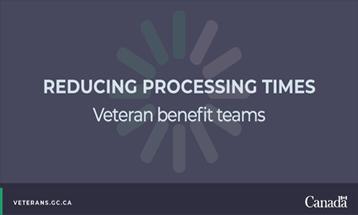Do we have everything?
A complete Disability Benefits (Pain and Suffering Compensation/Disability Pension) application will have all the information we need to decide if your diagnosed medical condition is related to your service. In this first step, we will review your:
- Medical reports or Canadian Armed Forces/Royal Canadian Mounted Police health reports;
- Medical questionnaire(s);
- Service health records; and if needed one or all of the following,
- Proof of identity, Consent for VAC to Collect Personal Information from Third Parties, and/or the Direct Deposit Request form.
Learn more about how to complete an application for a disability benefit.
Who reviews the application?
Once your application is reviewed and we have all the necessary pieces, it is queued up for assignment to a decision maker.
Sometimes, the decision maker identifies missing information. If that happens, you will be notified and your application will be placed on hold until it is received.
Decision makers review every application. If you have released or are a current or former RCMP member, we will send you a medical questionnaire to be completed by your treating health care practitioner. If you are a serving Canadian Armed Forces member, we will review your service health records for a current diagnosis. For all claims, we will review your service health records to confirm a link between your service and your claimed condition.
How is my service covered?
If your service records show that you were serving in the Second World War, the Korean War, a Special Duty Area or Special Duty Operation when you became ill or were injured, any disability from that service is covered by the Insurance Principle, which provides 24-hour coverage.
If you were serving during peacetime, you will be covered through the Compensation Principle, which provides coverage for an illness or injury that occurred while you were on duty.
Tools used to review the application
If there is clear medical evidence of a chronic or permanent disability, decision makers must then determine:
- Your entitlement – is the disability directly or partially related to service?
and - Your assessment – what is the severity and extent of the disability and its impact on your quality of life?
To ensure that all decisions are fair and consistent, a decision maker uses the following tools to review your entitlement and assessment:
- Entitlement Eligibility Guidelines (EEGs): Based on evidence from peer-reviewed medical research and literature both in Canada and abroad, the EEGs are policy statements that ensure the consistency, equity and quality of decisions made on applications for service-related disabilities.
- Table of Disabilities: The table is used by decision makers to assess the extent of a disability for the purposes of determining disability benefits. Specifically, to assess the level of an impairment and the impact on your quality of life.
- Medical Questionnaires: The purpose of a questionnaire is to support your diagnosis and supplement the information from the Table of Disabilities.
The decision letter
You will receive a decision letter once your application is reviewed by a decision maker. If you have a service-related disability, the letter will also show your entitlement and your assessment.
If you receive an unfavourable decision, the letter will explain why and what evidence was used to make the decision, and provide information on how to contact the Department if you have any questions. The letter will also explain your review and appeal options if you have new evidence or if you do not agree with a decision.
Additional information
Learn more about how to provide all the components of a complete application for a disability benefit.
How long does it take to be approved for a disability benefit?
We are committed to providing decisions as quickly as possible. To complete your application, decision makers must use only the evidence they receive. Once decision makers receive all the information they require – complete and signed form(s), service records, medical reports and questionnaire(s) – they can usually begin making a decision.
This timeframe will vary depending on several factors such as:
- the complexity of your condition;
- the complexity of the medical reports and questionnaires explaining that condition;
- how long it takes to receive service health records from the Department of National Defence or Library and Archives Canada;
- the level of detail (or lack of detail) in those service health records; and
- any challenges in getting other needed evidence to support your application.
The Wait time tool provides current average wait times for receiving a decision on certain applications.



